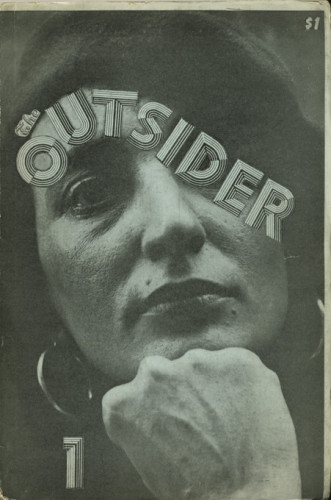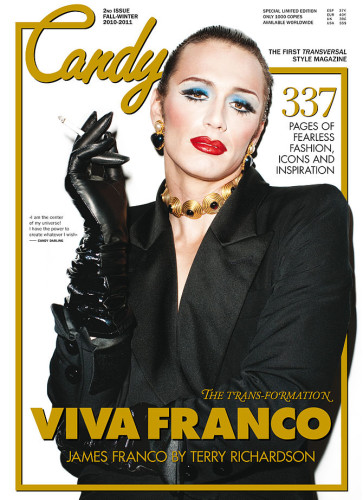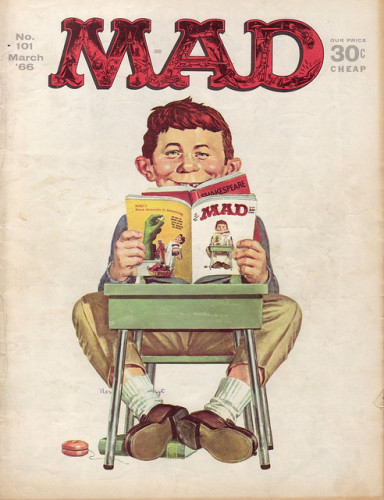Editor’s Note: Last year, a new print-only magazine launched in New Orleans. Momma Tried is an arts, literature, and nudie magazine put out by Editor Micah Learned and Art Director Theo Eliezer. With contributions from nearly 50 collaborators, Momma Tried is a daringly shared work of writers, models, fashion designers, photographers and visual artists, tightly woven by Learned and Eliezer’s curatorial third eye. NolaVie talked to Micah and Theo about the premier issue, and as they raise funds to bring Issue 2 to print, the pair is back to talk about the top magazines and periodicals that inspire their own product.
Micah’s Picks:
 The Double Dealer: A National Magazine for the South began in reaction to the widespread view of New Orleans and the South, in general, as provincial and artistically stunted. During the French Quarter Renaissance from January 1921 until May 1926, the Double Dealer published an enormous range of seminal authors of varying race, gender and sexual orientation years before most other literary journals would notice the likes of Jean Toomer, Djuna Barnes, Hart Crane and Robert Penn Warren. Many of its covers were illustrated by Aubrey Beardsley, whom Theo absolutely adores. And William Faulkner and Ernest Hemingway not only published their first poems in the Double Dealer, but their verse appeared in the same edition on the same page in June 1922.
The Double Dealer: A National Magazine for the South began in reaction to the widespread view of New Orleans and the South, in general, as provincial and artistically stunted. During the French Quarter Renaissance from January 1921 until May 1926, the Double Dealer published an enormous range of seminal authors of varying race, gender and sexual orientation years before most other literary journals would notice the likes of Jean Toomer, Djuna Barnes, Hart Crane and Robert Penn Warren. Many of its covers were illustrated by Aubrey Beardsley, whom Theo absolutely adores. And William Faulkner and Ernest Hemingway not only published their first poems in the Double Dealer, but their verse appeared in the same edition on the same page in June 1922.
The Outsider: As partners making a magazine, we readily identify with Gypsy Lou Webb and her husband Jon Edgar, who, in the 1960’s, printed the Outsider in a smattering of apartments along Royal and Ursuline not far from where Theo has lived for years. They published a number of the most famous Beat writers including Kerouac, Ferlinghetti and Ginsberg. Gypsy Lou pressed flowers into many of its pages, and they set the type and bound the mags at their home. It was acknowledged in its time as a premier literary journal by the New York  Times, but their highest achievement was in recognizing the singular talent of Charles Bukowski, who Lou and Jon brought from obscurity to national prominence through multiple publishings in the Outsider. They also published his first two books of poetry through their own Loujon Press.
Times, but their highest achievement was in recognizing the singular talent of Charles Bukowski, who Lou and Jon brought from obscurity to national prominence through multiple publishings in the Outsider. They also published his first two books of poetry through their own Loujon Press.
Toilet Paper: Maurizio Cattelan has said that creating a Toilet Paper image is like “distilling a perfume.” And to hell if that flowery bullshit isn’t true. Toilet Paper magazine is all images, all double page and all full-bleed. Each new photograph combines a wallop of nostalgia with tense overtones of camp grotesquery and brisk colorful playfulness that hit with all the ambiguity and memories of a scent — you’ve sensed the look before in the back alleys of internet porn, under the dim light of an open refrigerator, in a pet shop or next to your grandmother as she filed her nails.
What began in 2010 as a self-publishing project between Cattelan and Pierpaolo Ferrari, has become a visual brand that everyone from VICE to Purple Magazine to Vogue and Elle to fashion labels like Kenzo and Paris’ uber-hip store, Colette, are clamoring to be associated with. Though the widespread proliferation of their work is surprising and inspiring, the duo’s rapid rise can’t really be described as meteoric. Ferrari is a long time fashion photographer and Cattelan is one of the art world’s brightest stars, not to mention a personal favorite.
Esquire: I could just toss names of writers onto the page and that would do plenty towards showing the bounty 
and glory that was Esquire once upon a time. Under the editorship of Harold Hayes from 1963 to 1973, Esquire towered over the golden age of magazines. Hayes assembled a stable of writers who irrevocably changed the face of journalism in America and made it “New.” But they — Nora Ephron, Tom Wolfe, Gay Telese, Joan Didion, Norman Mailer, Gore Vidal and on and on — also defined the era and became a part of our national canon.
More general interest than men’s magazine, Esquire dealt with issues of the day from women’s rights and segregation, to the Vietnam War and beyond in real time with a level of acuteness and artistry rarely seen before or since. It was incredibly well edited, but our greatest influence in regards to Momma Tried are the covers and Art Direction by George Lois during the same period. They were as controversial then as they are iconic today, and they collectively serve as an inspirational compass each time we sit down to design our covers.
Theo’s Picks:
HUP: R Crumb is pretty much the master of merging filthy politically incorrect content with next-level artistic skill, and for me, HUP is among his best work. Published in the early 80’s it was a departure for Crumb because for the first time he was writing the narratives before drawing the illustrations, so the story lines are exceptionally strong.
I first discovered HUP in a shitty record store in Haight Ashbury in San Francisco around the age of 15 and it totally blew my mind. I mean, how could you be introduced to Devil Girl as a teenager and not be changed in some way? I was scandalized, but also totally in love with R Crumb’s depictions of savage women with big butts and thick thighs, and this was the first time I had seen women depicted in this way. As deranged as the storylines are, my young self was exposed to a new more empowered perspective on the female body through R Crumb’s characters, so his comics (and HUP in particular) will forever hold a place in my heart.
Interview: Between the iconic covers by Richard Bernstein, it’s origin in 1969 as an underground magazine, and Warhol at the helm shaping the magazine’s vision, by our standards the first two decades of Interview is a clear example of the golden age of print. Most known for their signature format of celebrities interviewing other celebrities, Warhol also regularly took the role of interviewer (often accompanied by his entire entourage); influential artists and writers such as Robert Mapplethorpe and Truman Capote contributed to their pages, and for a time, Interview magazine was at the center of the NY zeitgeist intersection of the queer underground, glamorous disco queens, drugs, celebrities and art that exemplified the era between the end of the Vietnam war and the rise of AIDS.
Candy: It’s always wonderful to see creative people producing work that challenges rigid gender norms, so  naturally we’re fans of Luis Venegas’ Candy, which is devoted to trasvestism, transsexuality, cross dressing and androgyny in the form of a super chic glossy fashion magazine. Although Venegas only prints Candy in editions of 1000-1500, the magazine’s message has been able to reach a much wider audience thanks to his numerous covers and editorials featuring celebrated transgender models, like Andreja Pejic, and well known celebrities, like James Franco and Jered Leto, styled in drag.
naturally we’re fans of Luis Venegas’ Candy, which is devoted to trasvestism, transsexuality, cross dressing and androgyny in the form of a super chic glossy fashion magazine. Although Venegas only prints Candy in editions of 1000-1500, the magazine’s message has been able to reach a much wider audience thanks to his numerous covers and editorials featuring celebrated transgender models, like Andreja Pejic, and well known celebrities, like James Franco and Jered Leto, styled in drag.
Playboy: In my opinion, Hugh Hefner is a total role model, and his leadership and vision during Playboy magazine’s heyday of the 60’s to mid 70’s is an ongoing inspiration. He founded Playboy out of his kitchen in Chicago, in 1953 with the aim of creating a publication that appealed to the intellectual man. Central to this was an approach of portraying the nudity and sexuality of women in a way that divorced it from previous associations with unwholesomeness and prostitution. Instead, Hefner platformed the female body and sexuality as natural, elegant and belonging to the “girl next door,” which in the 50’s, was a radical departure from the norm of mainstream magazines and a form of rebellion against the societal bias against women.
In the 60’s, during the height of Playboy’s cultural influence, Hefner founded the Playboy Foundation, which provided funding to non-profits that were combating censorship and groups researching human sexuality, as well as joining the fight to overturn archaic birth control and abortion laws. Hefner was a staunch defender of civil rights, the sexual revolution and anti-censorship, and these views were represented both in the numerous projects of the brand of Playboy Enterprises and on the pages of Playboy magazine. Also famous for its amazing literary content and journalism, Playboy published blacklisted authors when almost no one else would do so, along with works by some of the most celebrated writers of the 20th century such as Gabriel Garcia Marquez, Margaret Atwood, Norman Mailer, Jack Kerouac and Kurt Vonnegut, among numerous others.
Regardless of the direction the magazine took after Hefner’s stroke in 1985, which seemed to mark a new era for Playboy, I’m convinced that Hefner’s genius IQ of 152 is evident in the clarity of purpose that he had for Playboy during its golden age.
MAD: Although its period of greatest relevance was the 50’s-70’s, when I discovered MAD magazine as a child of  the 90’s I felt like I had found something improbably wonderful. MAD is based on a foundation of social and political satire, and thinking back on it, I’m not sure how much of the magazine I actually understood, but I still thought it was hilarious.
the 90’s I felt like I had found something improbably wonderful. MAD is based on a foundation of social and political satire, and thinking back on it, I’m not sure how much of the magazine I actually understood, but I still thought it was hilarious.
I remember reading it on airplanes and at my grandparents house and in the backseat of cars and wondering what sort of adults were behind this mystifying collection of immature jokes, games and confusing references, all of which I found equally entertaining and unsettling. MAD has received tremendous praise and critical acclaim for its decades of widespread cultural influence, and for 44 years (from 1957-2001), it held the position as the most successful ad-free magazine published in America.
Created as a cheeky response to the popularity of magazine fold-outs in the 60’s, particularly Playboy’s nude centerfolds, my favorite part of every copy of MAD was the recurring “MAD fold-in” feature by Al Jaffee. I was always so excited to figure out what the punchline was and struggled to overcome the limitations of childhood hand-eye coordination in order to fold the page accurately enough to decipher the messages hidden within.
*Momma Tried is pre-selling copies of Issue 2 at their normal retail price to raise printing costs. Check out the Kickstarter campaign and video.
 New Orleans Startups
A brief overview of the growing New Orleans startup scene. This piece highlights the main industries of New Orleans, competing cities, and just how emerging the current entrepreneurial/startup scene is in New Orleans.
New Orleans Startups
A brief overview of the growing New Orleans startup scene. This piece highlights the main industries of New Orleans, competing cities, and just how emerging the current entrepreneurial/startup scene is in New Orleans.
 A Bin in Every Classroom: Why Tulane Should Lead on Composting
I asked a peer, Isabel, for her thoughts on composting: “Why do...
Tulane
A Bin in Every Classroom: Why Tulane Should Lead on Composting
I asked a peer, Isabel, for her thoughts on composting: “Why do...
Tulane